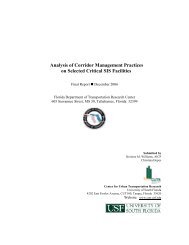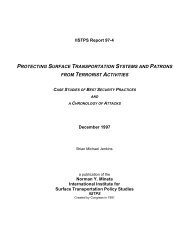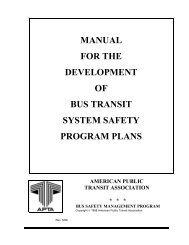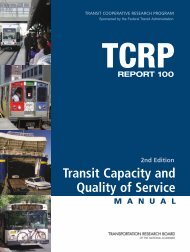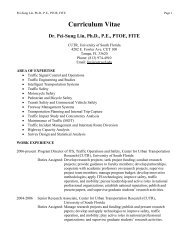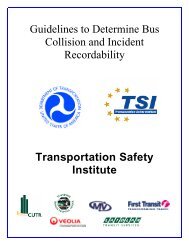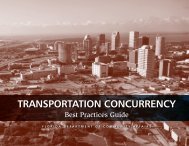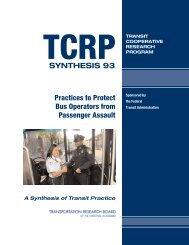a technical guide for conducting pedestrian safety assessments
a technical guide for conducting pedestrian safety assessments
a technical guide for conducting pedestrian safety assessments
Create successful ePaper yourself
Turn your PDF publications into a flip-book with our unique Google optimized e-Paper software.
UNIVERSITY OF CALIFORNIA BERKELEY • INSTITUTE OF TRANSPORTATION STUDIES • TECHNOLOGY TRANSFER PROGRAM<br />
5<br />
The experience of the City of El Cajon in Southern Cali<strong>for</strong>nia offers an example of the economic vitality benefits of improving<br />
walkability. In 1999 the city launched a downtown revitalization ef<strong>for</strong>t, which included a “road diet,” or reduction<br />
in the number of lanes/ road width on East Main Street. The road diet led to slower traffic and created room <strong>for</strong><br />
widened sidewalks with outdoor dining, landscaping, street furniture, and bulb-outs at intersections. In addition to the<br />
road diet, the city adopted a land use plan to add significant new housing units, offices, and retail; issued development<br />
<strong>guide</strong>lines to ensure that new development occurs with an urban <strong>for</strong>m that supports walking; and enhanced nearby<br />
<strong>pedestrian</strong> walkways to connect to East Main Street. The Community Development Corporation also began sponsoring<br />
events to attract people downtown. The downtown revitalization has been significant. Property values have increased by<br />
181 percent and taxable sales have increased by 66 percent downtown (compared to 75 percent and 45 percent,<br />
respectively, in the city at large). Additionally, hotel taxes have increased by 36 percent, lease rates have increased by<br />
56 percent, and crime has decreased by 16 percent. The private sector has invested more that $43 million downtown,<br />
and 179 new businesses and 746 new jobs have been created (Pedestrian and Bicycle In<strong>for</strong>mation Center).<br />
There are other similar economic vitality “success stories,” as shown in the brochure, “Economic Benefits of Walkable<br />
Communities,” published by the Cali<strong>for</strong>nia Local Government Commission (www.lgc.org).<br />
Economic vitality is an integral part of the following <strong>technical</strong> components of the Cali<strong>for</strong>nia PSA.<br />
Figure 1: Sidewalk Cafes after East Main Street Road Diet (walkinginfo.org)



